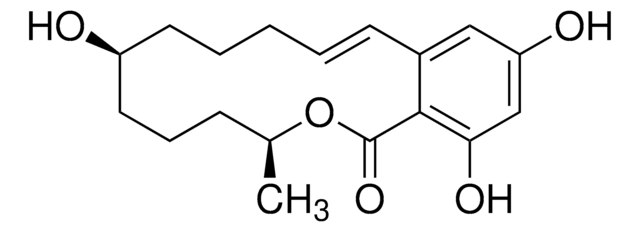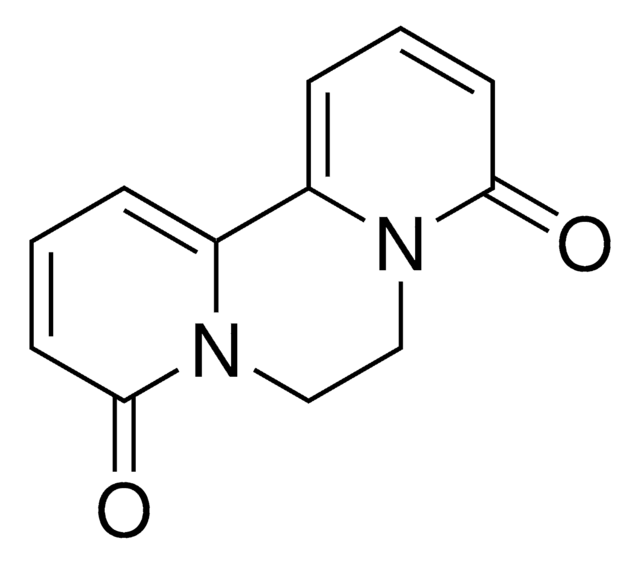CRM16869
Diquat metabolite Monopyridone
certified reference material, TraceCERT®, Manufactured by: Sigma-Aldrich Production GmbH, Switzerland
Sinônimo(s):
1-Oxo-9,10-dihydro-1H-10a-aza-8a-azoniaphenanthrene chloride, 6,7-Dihydro-9-oxo-9H-dipyrido[1,2-a:2′,1′-c]pyrazin-5-ium chloride
About This Item
Produtos recomendados
grau
certified reference material
TraceCERT®
Nível de qualidade
linha de produto
TraceCERT®
prazo de validade
limited shelf life, expiry date on the label
fabricante/nome comercial
Manufactured by: Sigma-Aldrich Production GmbH, Switzerland
formato
neat
temperatura de armazenamento
2-8°C
cadeia de caracteres SMILES
O=C1N2CC[N+]3=CC=CC=C3C2=CC=C1.[Cl-]
Procurando produtos similares? Visita Guia de comparação de produtos
Categorias relacionadas
Descrição geral
Certified content by quantitative NMR incl. uncertainty and expiry date are given on the certificate.
Download your certificate at: http://www.sigma-aldrich.com
Diquat monopyridone is a common degradation product of Diquat. Diquat is a nonselective, defoliant, preharvest, and desiccant herbicide that belongs to the bipyridinium class. Diquat can rapidly penetrate through the leaf surface but is not taken up by the roots, due to its strong adsorption onto the soil particles. Its activity is based on the liberation of the superoxide anion radical, followed by hydrogen peroxide, causing tissue destruction by oxidative stress. The herbicidal activity of diquat is more pronounced in daylight, aerobic conditions, high humidity, and temperature.
Diquat is not approved for its use in the European Union. The maximum residue limit (MRL) for diquat presence in the crops varies between 0.05 mg/kg in most of the commodities to 10 mg/kg for linseed and barley.
The EU residue definitions are broader, however, the toxicological data is still missing for the diquat metabolites, monopyridone and dipyridone, to compare their toxicity with the parent compound.
Aplicação
- Detection of two diquat metabolites in urine and serum of poisoned patients after ingestion of combined herbicides, paraquat and diquat
- Analysis of paraquat, diquat, and two diquat metabolites in biological materials by high-performance liquid chromatography coupled with UV and fluorescence detectors
Informações legais
Palavra indicadora
Danger
Frases de perigo
Declarações de precaução
Classificações de perigo
Acute Tox. 2 Inhalation - Acute Tox. 3 Dermal - Acute Tox. 3 Oral - Aquatic Acute 1 - Aquatic Chronic 1 - Eye Irrit. 2 - Skin Irrit. 2 - Skin Sens. 1 - STOT RE 1 Oral - STOT SE 3
Órgãos-alvo
Respiratory system
Código de classe de armazenamento
6.1A - Combustible acute toxic Cat. 1 and 2 / very toxic hazardous materials
Classe de risco de água (WGK)
WGK 2
Ponto de fulgor (°F)
Not applicable
Ponto de fulgor (°C)
Not applicable
Choose from one of the most recent versions:
Certificados de análise (COA)
Don't see the Right Version?
If you require a particular version, you can look up a specific certificate by the Lot or Batch number.
Já possui este produto?
Encontre a documentação dos produtos que você adquiriu recentemente na biblioteca de documentos.
Nossa equipe de cientistas tem experiência em todas as áreas de pesquisa, incluindo Life Sciences, ciência de materiais, síntese química, cromatografia, química analítica e muitas outras.
Entre em contato com a assistência técnica
![[Des-Tyr22]-Calcitonin salmon](/deepweb/assets/sigmaaldrich/product/images/282/634/15345f68-95be-4b5f-abc2-cb170099f26f/640/15345f68-95be-4b5f-abc2-cb170099f26f.jpg)






